

Paul Maric
This Tesla self-drove me 50km to Bunnings on its own (almost)
6 Days Ago
The Audi R8 has always been special if not unique in the world of mid-engine supercars. It still is.
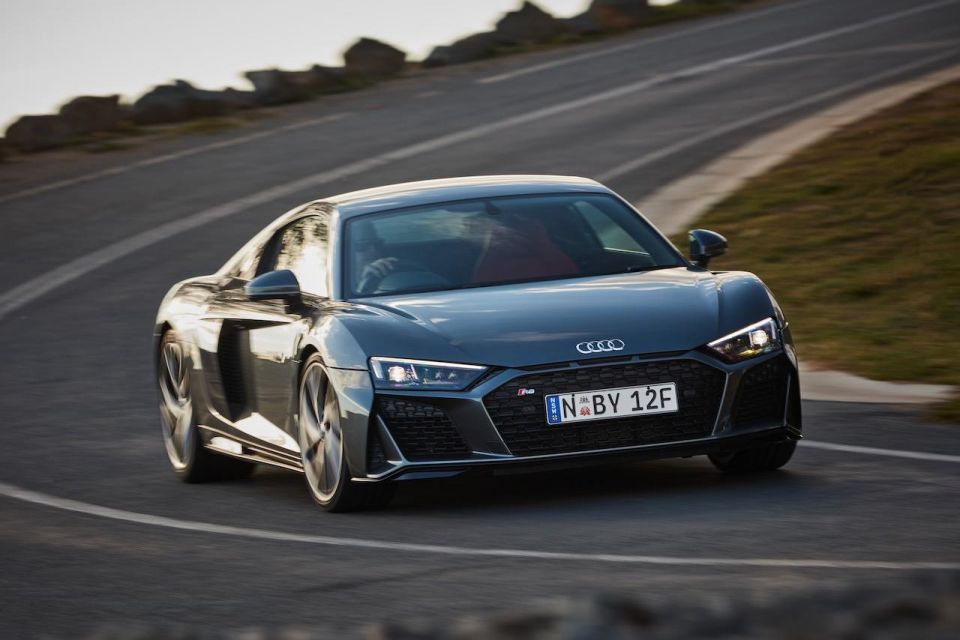
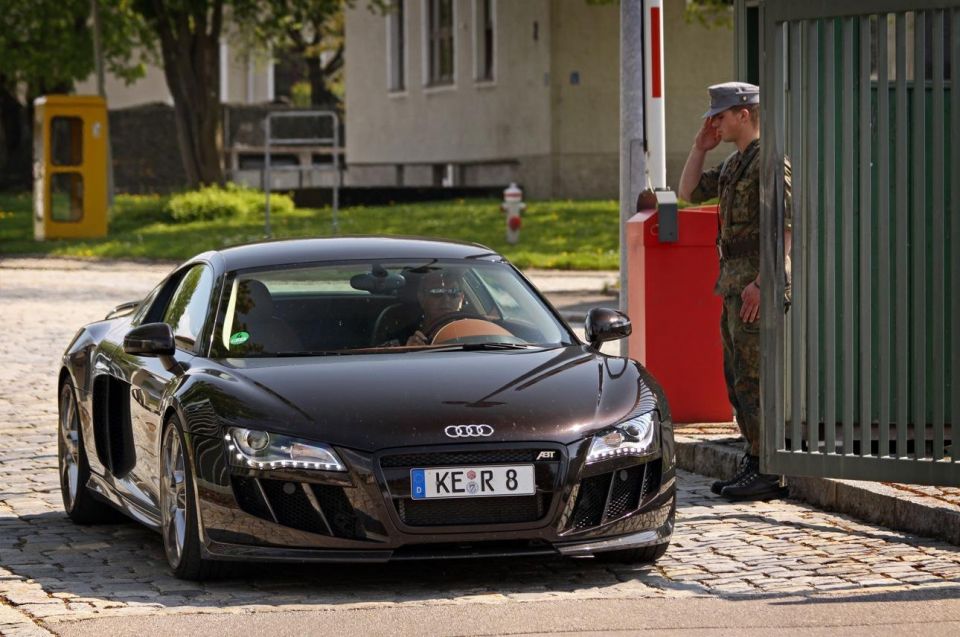

Senior Road Tester
New from
$295,000
excl. on-roads

Senior Road Tester
New from
$295,000
excl. on-roads


Senior Road Tester
New from
$295,000
excl. on-roads

Senior Road Tester
New from
$295,000
excl. on-roads
Quickly see how this car stacks up against its competition. Select any benchmark to see more details.
Where expert car reviews meet expert car buying – CarExpert gives you trusted advice, personalised service and real savings on your next new car.
I’ve got to go back more than 11 years for my first taste of an Audi R8. We picked it up in the small Bavarian town of Kempten at the headquarters of ABT Sportsline, a long-standing tuner that once prepared Audi GT racing cars.
As you might imagine, it was no ordinary Audi R8 V8. It was Christian Abt’s daily driver, one that’d been amped up using two superchargers along with a stiffer, more precise suspension that upped its performance capability like no car we’d ever driven, Bugatti Veyron aside.
Christian entrusted Alborz and myself with his car for video and high-speed autobahn testing that included an intense, fast-flowing 10km hill climb from a delightfully picturesque ski village not far from the Austrian border.

The views were breathtaking and the scene was set for some proper charging in Audi’s then-fresh supercar. The weather was cold and tyres were a bit worn, so even with the legendary quattro all-wheel drive system to lean on it tended to get a bit loose every time we punched it out of a corner.
The noise of the V8 at full cry was poetic but it was the six-speed manual transmission with an open gate and a knurled-knobbed shifter that made a click-click sound every time is slipped into a different gear inspired most. It was mesmerising – addictive – as was every minute spent in the car.
Our collective reaction after a few hours behind the wheel was one of astonishment. These were full-tilt runs that proved the R8 had superb balance, linear power delivery and exceptional handling, steering and braking.
The following day things only got better, when Alborz was in the driver’s seat and belting along a small stretch of autobahn nearby and proceeded to wind the car up with our videographer riding shotgun, camera steadfastly trained on the speedometer.
The Audi R8 reached an incredible 321km/h before he backed off because of traffic. That video went viral and attracted well over a million views.
In the end, we’d been totally spoilt for speed by the ABT R8 because when we finally jumped into a regular 4.2-litre R8 back in Australia, it felt painfully slow. It wasn’t until a few months later when we got the opportunity to pilot the newer 5.2-litre V10 version did we find an R8 that stirred the soul.
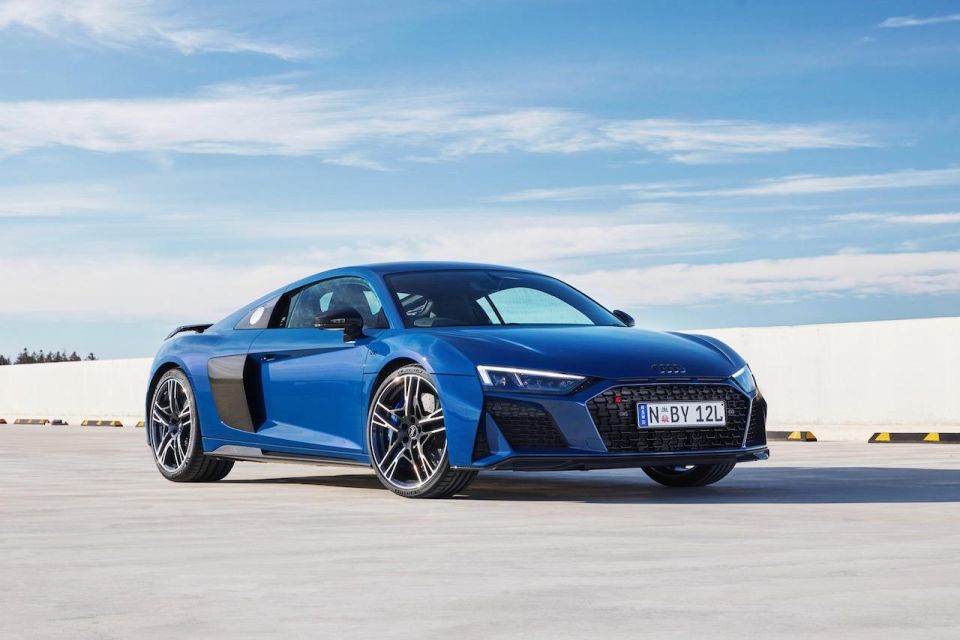
Years would pass before I would finally get the opportunity to attempt max velocity in the second-generation Audi R8 back in Germany, only now it was called the V10 Plus Coupe with its 5.2-litre naturally-aspirated V10 making 449kW of power and 560Nm of torque, and one of the most intoxicating engine notes on the planet.
The Audi R8 V10 Plus was a proper supercar with brilliant responses and enough all-wheel drive grunt to smash the benchmark zero-to-100km/h sprint in 3.2 seconds.
Sadly, that glorious manual transmission had been deleted in favour of a quick-shifting seven-speed, dual-clutch transmission, along with a new kind aural addiction.
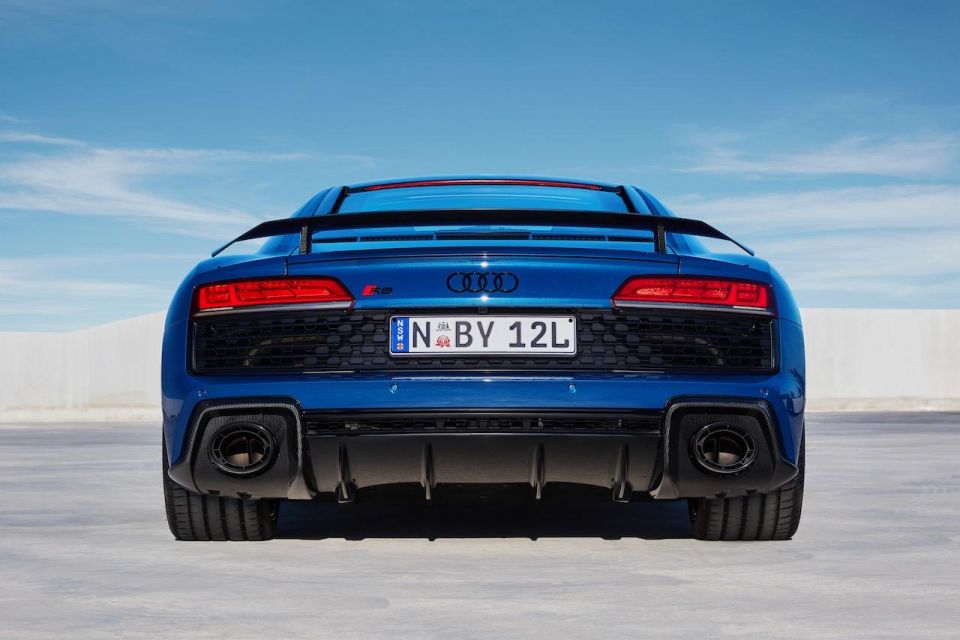
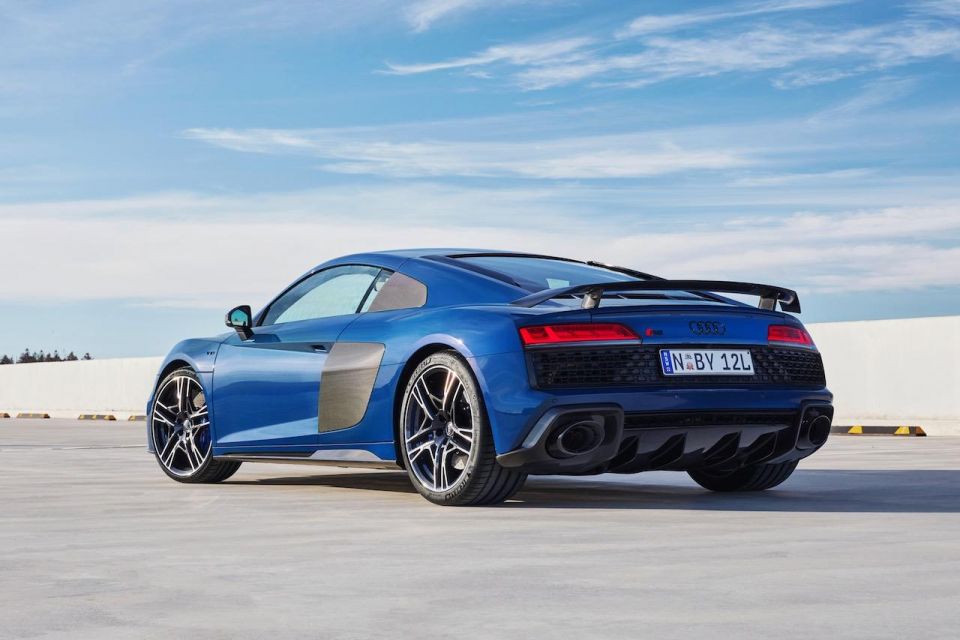
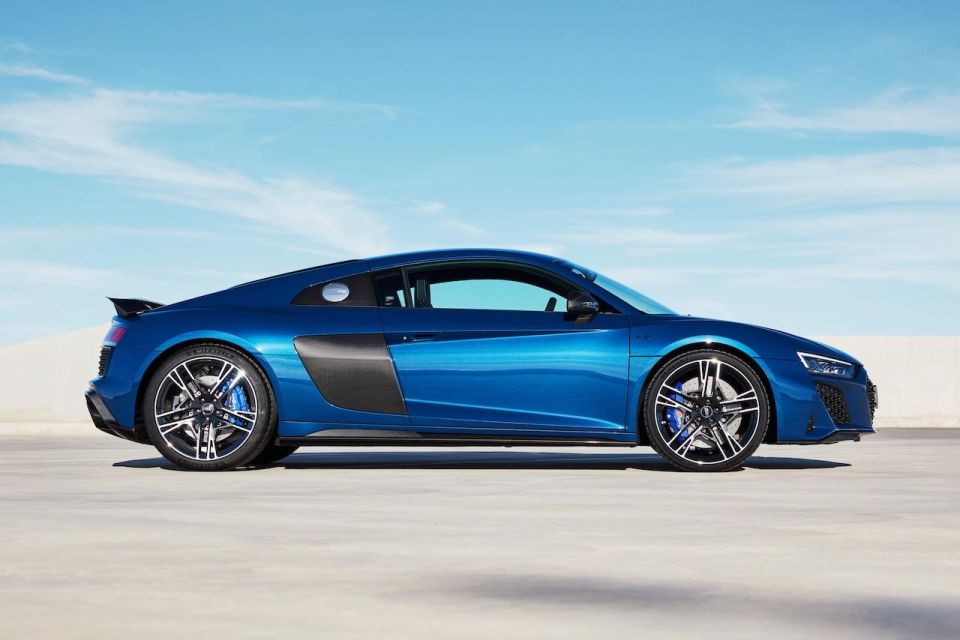
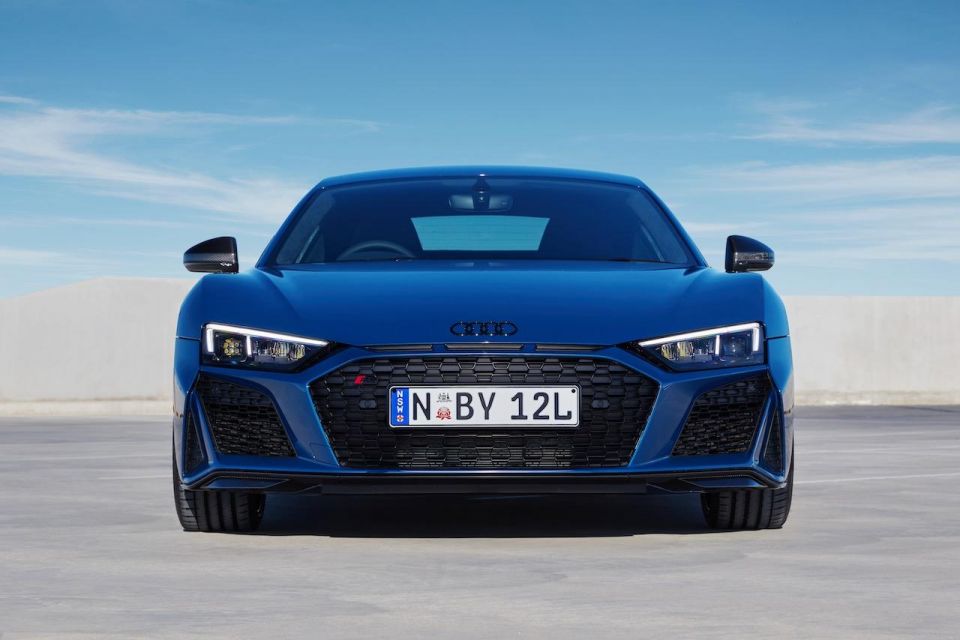
Top speed was 330km/h, but if my memory serves correctly we were only able to hit 267km/h before traffic on the autobahn intervened.
Audi’s latest 2020 R8 line-up is more of the same, only now there’s an entry-level rear-wheel drive version in coupe and Spyder bodies, sitting below the flagship V10 quattro model.
This is no makeover, it’s barely a nip and tuck. While there are subtle signs of visual tinkering, it seems a tad fussier and not for any real gains.
Here’s the problem. Most (if not all) the exterior enhancements on the new R8 appear to do little or nothing other than add extra plastic (or is it carbon-fibre) to fill in some small gaps – quite literally.
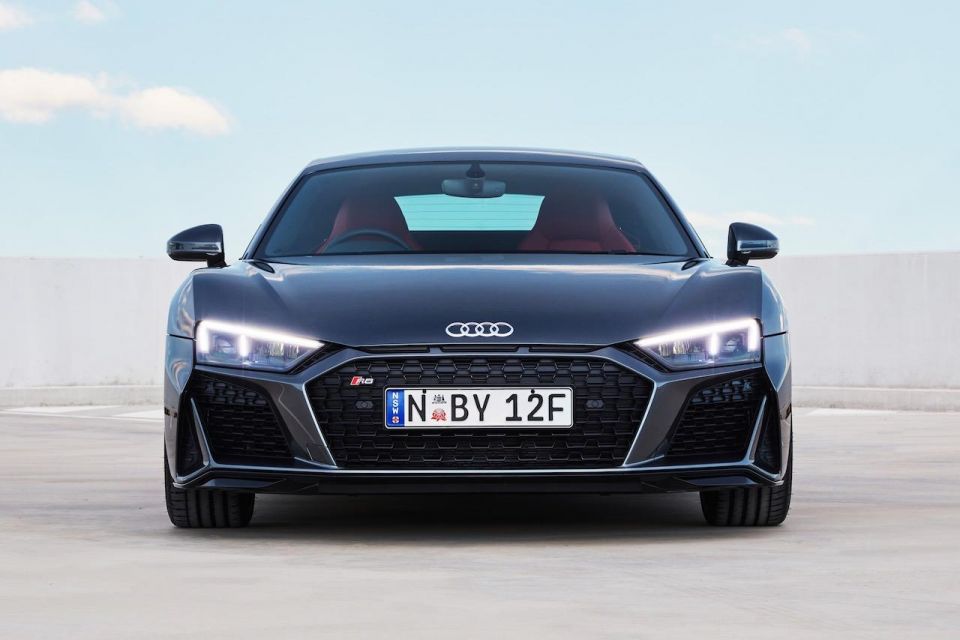
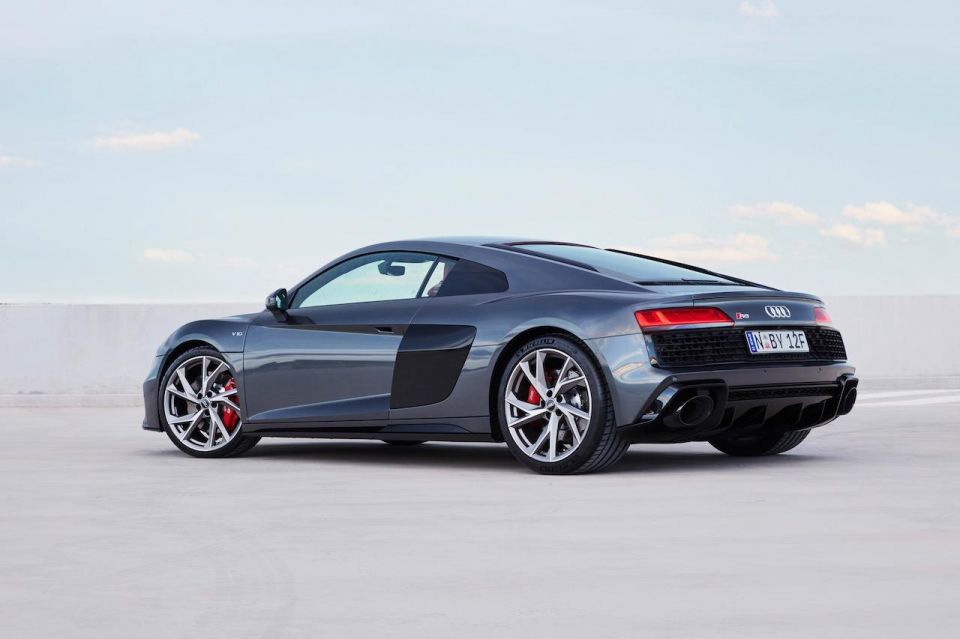
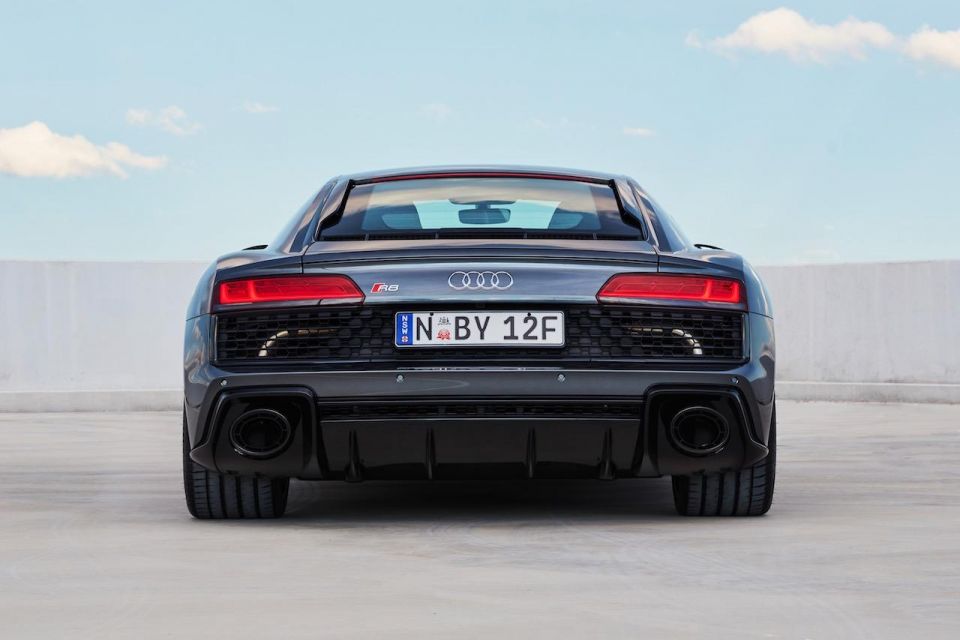
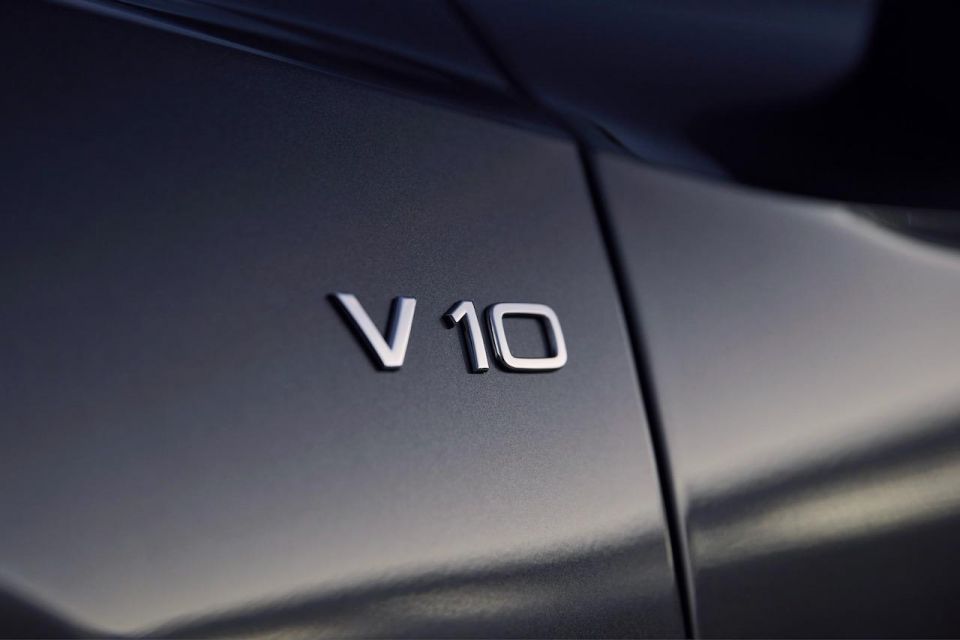
I’m not saying the Audi R8 doesn’t turn heads anymore, because it certainly does. I’d say the folks at Audi Sport have dialled up aggression with its wider and flatter grille in particular, while out back the air inlet spans the entire rear end.
The rear diffuser is deeper and neater, given it houses the large oval exhaust tips.
Dig a bit deeper though and there have been a few improvements. It’s worth noting both the R8 RWD Coupe and R8 V10 Performance quattro tip the scales at the same 1595kg, thanks to a few more carbon-fibre bits including a new front stabiliser. That alone saves 2kg.
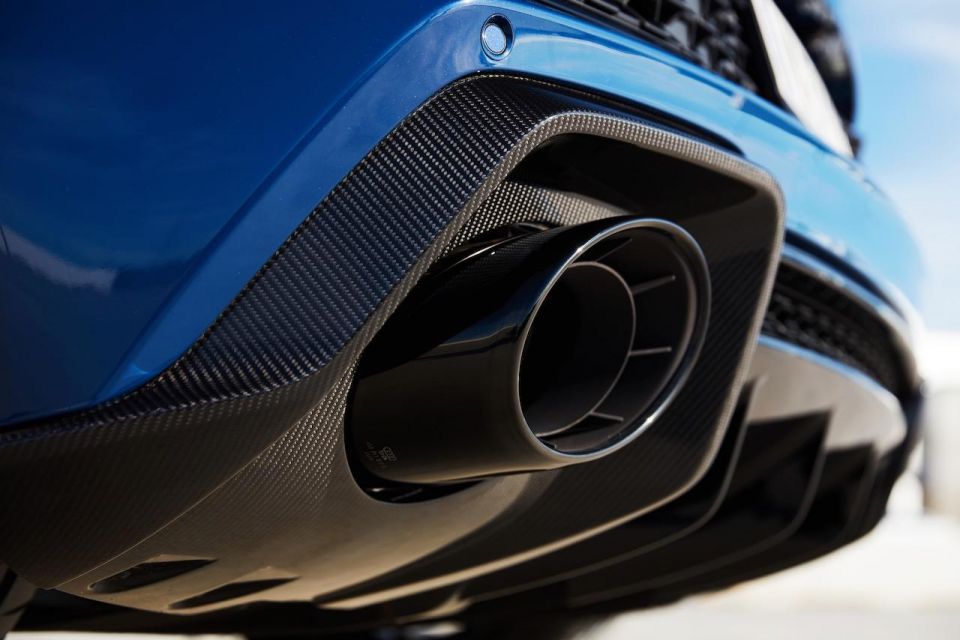
The double-wishbone suspension system has been modified on the R8 for faster response and better precision while aero has also been enhanced with an almost fully-sealed underbody, designed to reduce drag.
It’s just a shame the full-length side blade is gone, along with some of the car’s visual uniqueness.While I’m mournful, the same goes for that magnificent manual transmission in the first-gen car. Possibly the best manual shift in a production series car ever. Perhaps I’m just getting old.
That said, the second you climb aboard and fire up that V10 all is forgotten, and it only gets better with a clear road ahead.
For 2020 it’s a two-tiered range, kicking off with the V10 RWD from $295,000 before on-road costs and Spyder V10 RWD from $316,500 before on-roads.
The flagship version is the V10 Performance quattro at $395,000 before on-roads, while the Spyder V10 Performance quattro starts from $416,500 before on-roads.
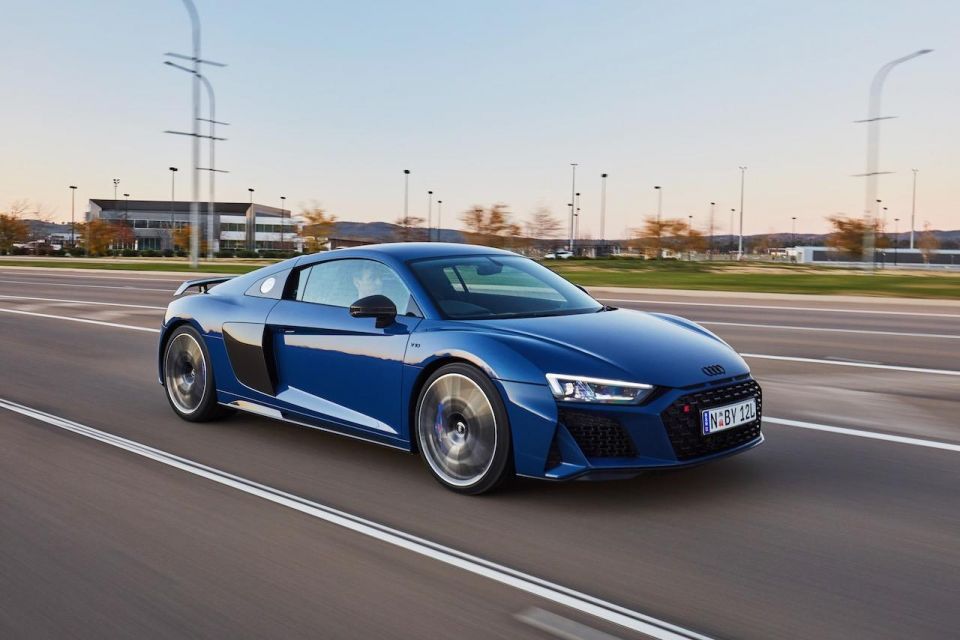
This means the entry-level rear-wheel drive R8 Coupe is now $4500 less expensive than the car it replaces, while the more powerful V10 Performance quattro carries a $5675 premium over its predecessor.
It’s a similar scenario with the Spyder versions. The 2020 V10 RWD model saves you the same $4500 over the old entry-level model, where the latest Audi R8 Spyder V10 Performance quattro commands a sizeable $28,000 premium.
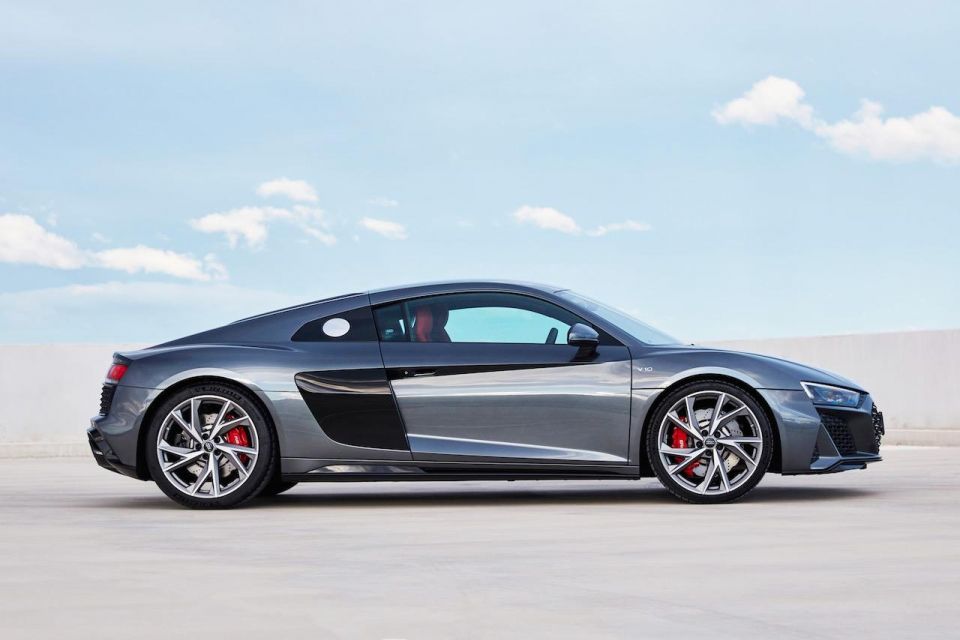
By way of comparison the R8’s direct rivals are the Aston Martin Vantage ($299,950) and Porsche 911 Carrera S ($275,000 or $292,200 for the 4S).
Closer to home, the entry rear-wheel drive LP580-2 Lamborghini Huracan using the same platform and 5.2-litre V10 starts at $378,900 but makes more power than the R8 RWD, while the all-wheel drive LP610-4 Evo costs $428,000 and gets identical outputs as the R8 Performance quattro.
Apart from the various visual and underbody upgrades mentioned, the latest Audi R8 RWD boasts an extensive list of standard kit such as any one of the nine metallic, pearl or crystal effect paint finishes which contrast with the Mythos black side blades.
I’ve always gelled with the R8’s regular sports seats for their contours and depth of cushioning. The red Nappa leather with contrast stitching in our tester looked and felt exquisite. Naturally they’re powered, with memory on the driver’s side.
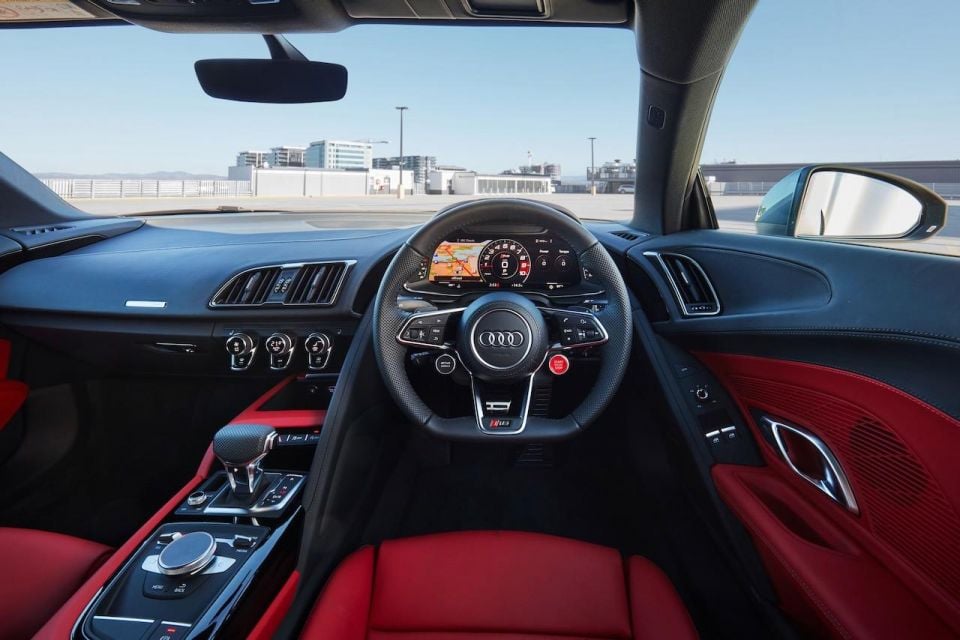
The bolsters might not look aggressive enough, but I’ve tried and tested these pews at pace over demanding bends and there are zero complaints from me.
More is less when it comes to seating in the R8 V10 Performance quattro, which gets more aggressive buckets with manual fore and aft adjustment, but electric seat height change. Visually they’re stunning, but they also hug a little tighter with heavier bolsters.
Nappa leather covers most of the cabin, offset by the piano black gloss inlays and the exquisite brightwork for which Audi is known in its top-shelf models. Honestly, you’d have to go to Bentley to fine the level of switchgear you find in RS models.
The cockpit is totally driver-centric, part GT racing and part high-end luxury. The centrepiece is the 12.3-inch high-definition Audi Virtual Cockpit digital instrument display that’s fully configurable.
It took me a while to work out what was what as far as controls and functions go, but most functions can be accessed from the R8’s superb flat-bottom steering wheel with integrated Drive Select and Start/Stop buttons.
In the V10 Performance you also get the convenience of a third button with marked with a chequered flag. Hit that for full attack mode.
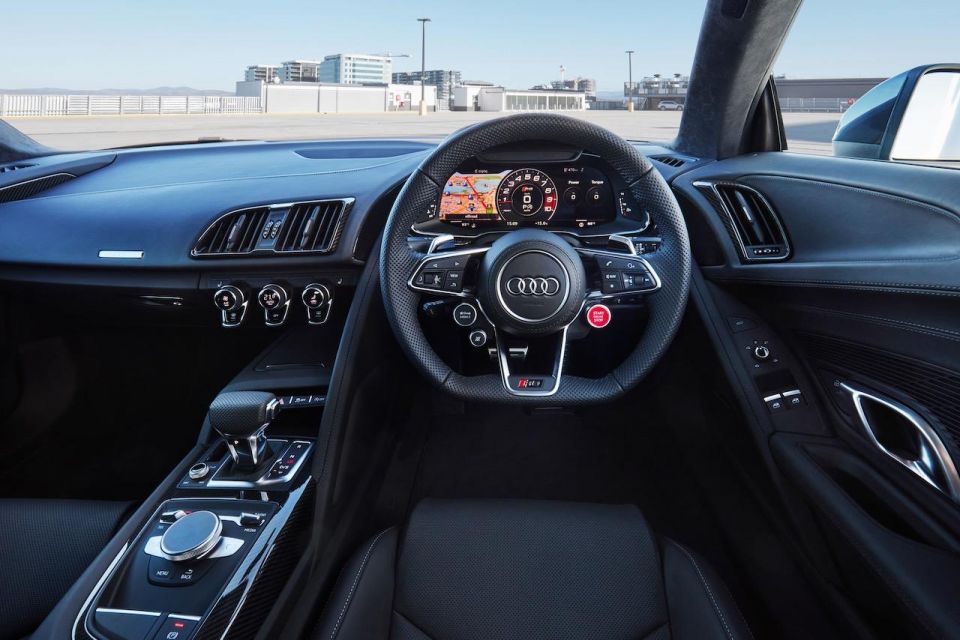
There aren’t a lot of buttons inside the R8, which has adopted a minimalistic approach for less distraction at high speeds. Everything you need to know is on the screen in front of you.
There’s also a rear-view camera (you’ll need that), heated and folding door mirrors, and heated seats as part of the R8’s standard inventory. The R8 also gets wireless phone charging, as well as CarPlay and Android Auto via USB.
And, for those unfortunate souls that ever get tired of the V10 holler, there’s a 13-speaker Bang & Olufsen audio system pumping out digital radio.
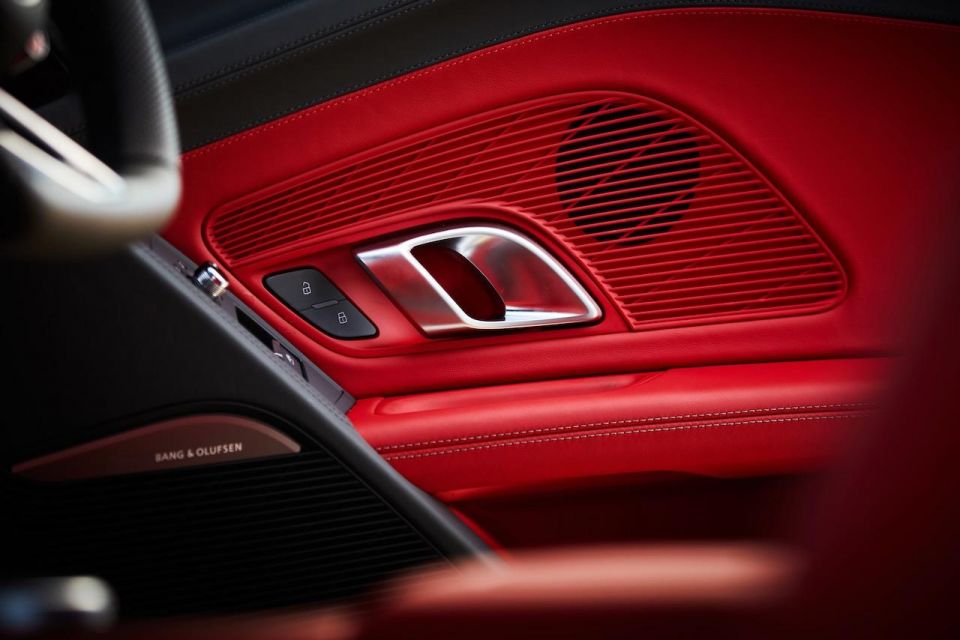
LED headlights darkened with dynamic indicators and Audi Laser lights are standard on both models, as is a sports exhaust, while the V10 Performance quattro gets side blades in gloss carbon.
The more powerful Audi R8 also utilises a carbon/aluminium space frame over the all-alloy frame of the entry model.
Standard 20-inch wheels grace the R8 RWD shod with 245/30 section fronts and 305/30s at the rear, while the R8 V10 performance quattro gets milled alloy versions (rather than cast alloy) in the same size.
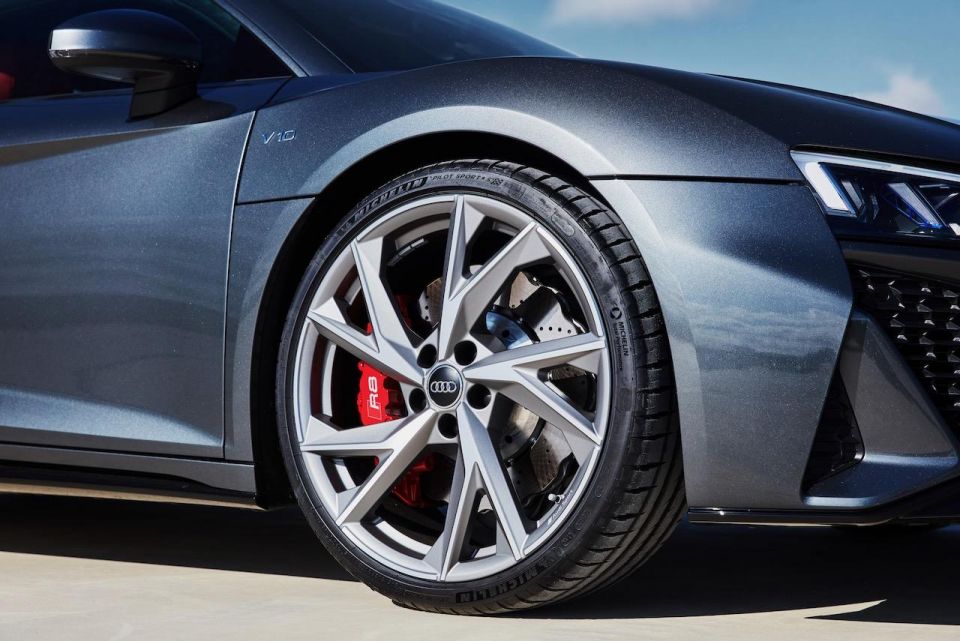
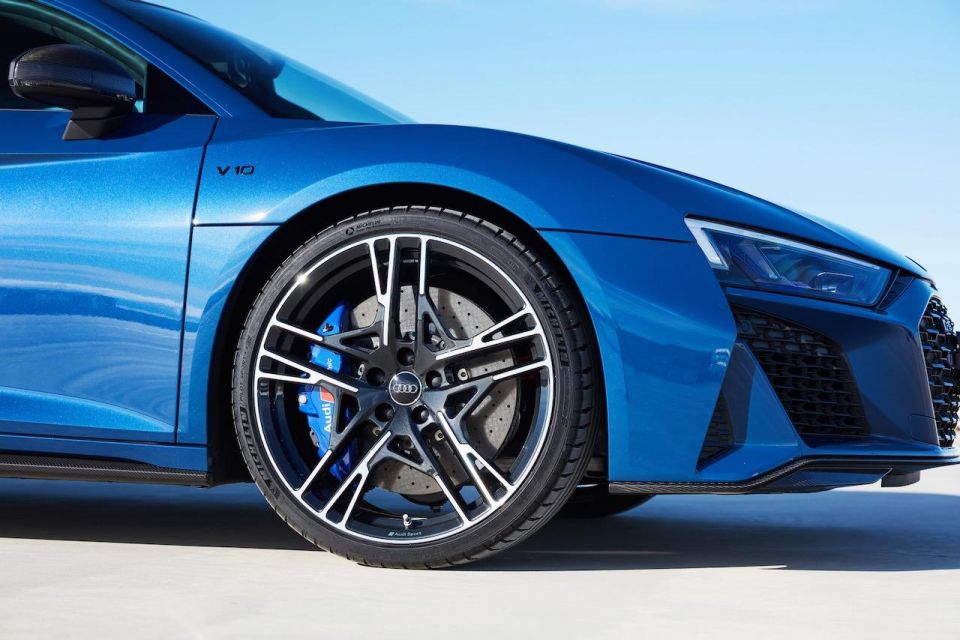
The Audi R8 V10 Performance quattro ditches the still-effective eight-piston steel brakes up front on the RWD model for carbon-ceramic rotors using six-piston calipers. Both are hugely impressive in their respective models.
There’s also a stack of options and option packs including those same carbon-ceramic stoppers on the RWD for a cool $21,400. Yeah, nah.
I’d be tempted to go with Audi rings and V10 badges (front and rear) in black for $700 and might even go as far as gloss black carbon side mirrors for $3200, or even a carbon side blade for $5000.
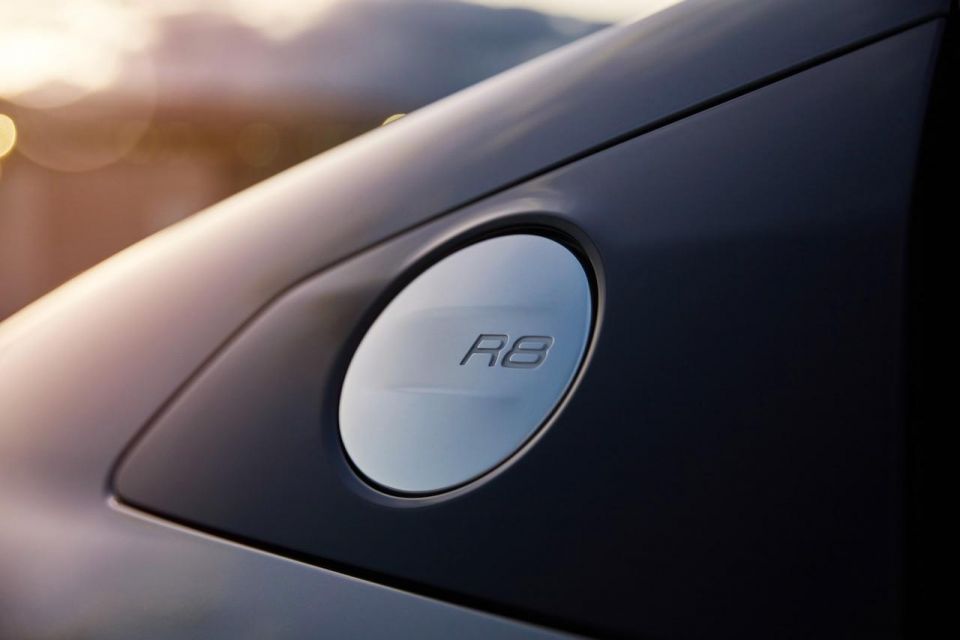
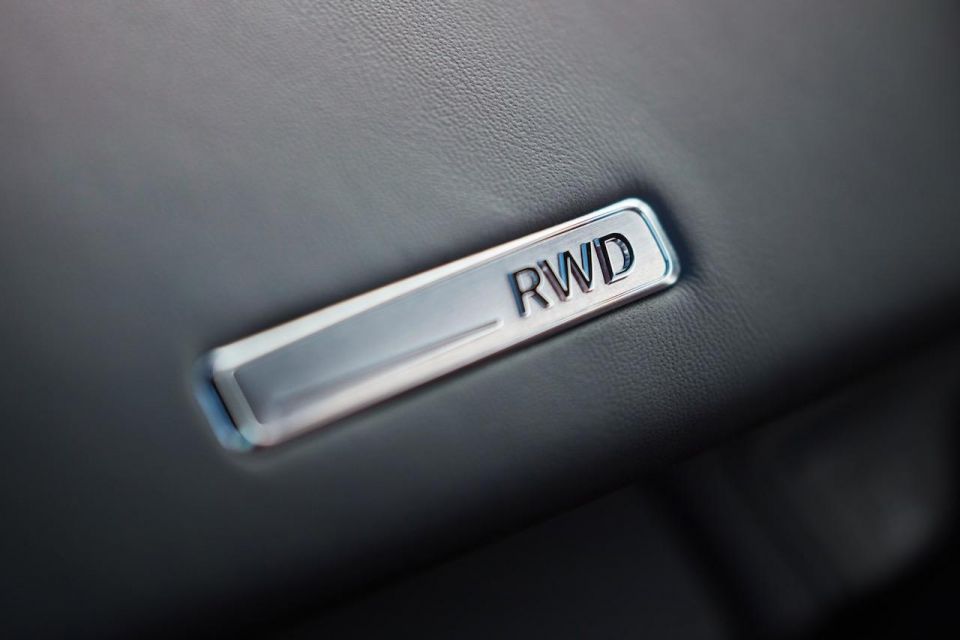
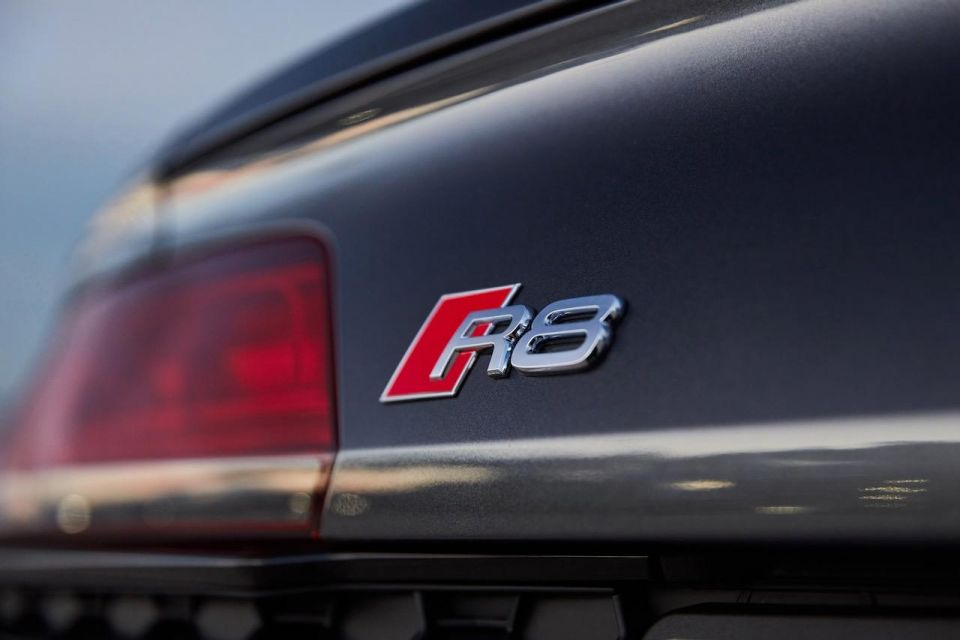
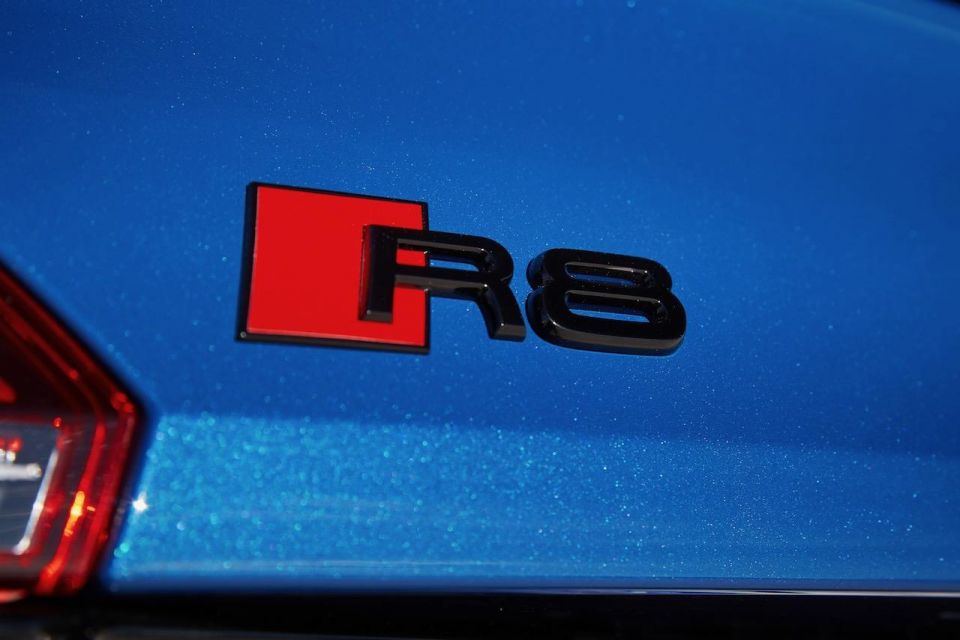
Packages for the R8 RWD are limited to the Carbon Interior package for the coupe for $7800 and $3800 for the Spyder. There’s also a carbon exterior package at $21,600 (coupe) and $23,800 (Spyder) but that’s about it.
The Audi R8 has not been crash tested and therefore does not have an ANCAP safety rating.
That said, there are two-stage airbags for the driver and front passenger, side airbags, and head-level curtain airbags in the Coupe.
While some supercars are a bit austere, the R8 in any guise offers a spectacular mix of luxury materials, tasteful architecture, a hardcore design that feels like a treat every time you get in.
The flat-bottom, three-spoke steering wheel in perforated leather is one of the best in the business, though, we’d dearly love to see some Lamborghini-size paddle shifters instead of the stumpy ones there currently.
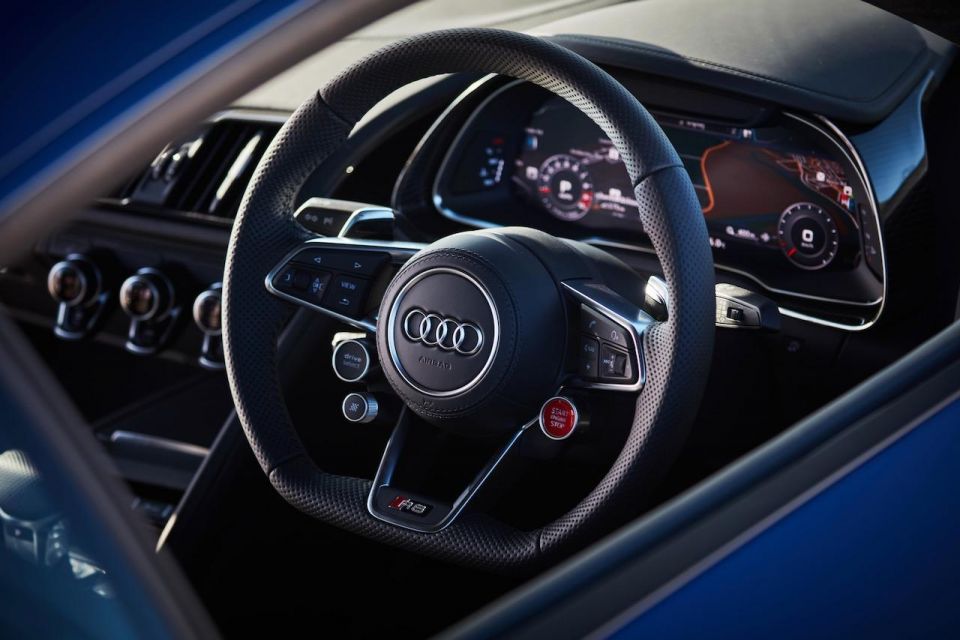
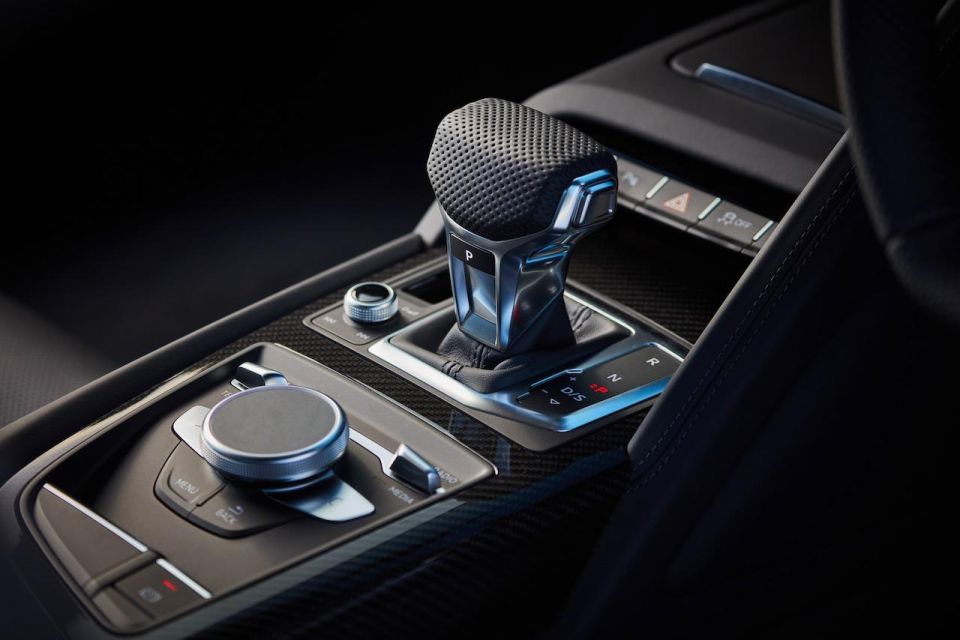
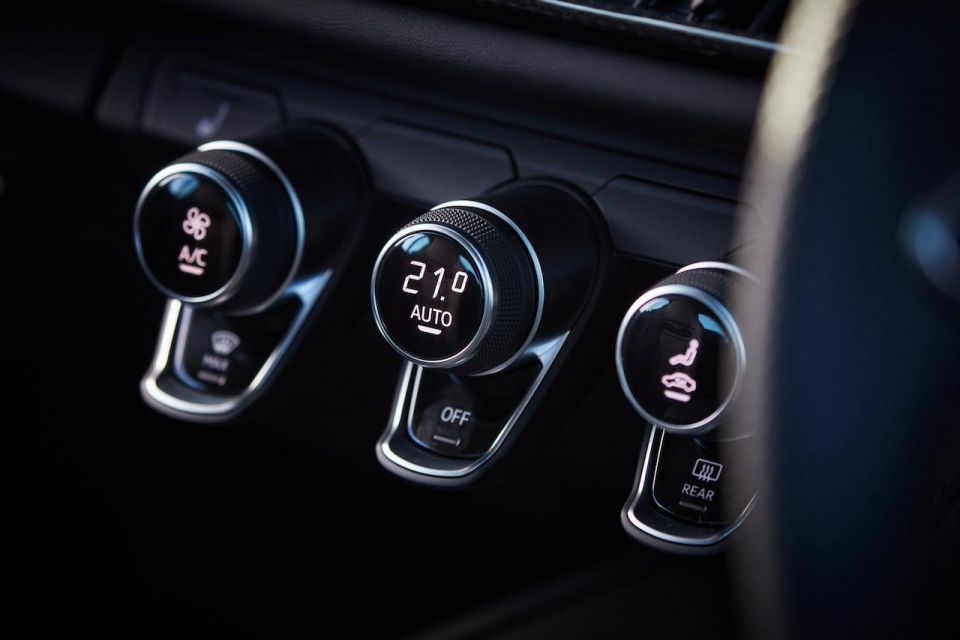
Where expert car reviews meet expert car buying – CarExpert gives you trusted advice, personalised service and real savings on your next new car.
I also can’t stop admiring the design work that’s gone into the three individual climate control dials. It’s nothing short of exquisite. It’s stuff like this that still makes the R8 feel special.
That said, it’s on the cusp of looking a bit yesterday against the likes of newer Audi RS models like the RS6 and even the RSQ3 we reviewed recently.
Specifically, it’s missing a centre-mounted infotainment screen. It’s no deal breaker, because the R8 has always been about that mid-mounted V10 and the noise it makes first and foremost.

As is the case in the 911, there’s room for several soft bags in the frunk for weekend trips.
Audi’s celebrated 5.2-litre naturally-aspirated V10 petrol engine developing a maximum 449kW of power at 8,50rpm and 560Nm of torque from 6500rpm in the V10 Performance quattro.
(Okay, it was technically developed by Lamborghini, which is owned by the Volkswagen Group – as are Porsche and Bentley)
It’s capable of going from standstill to 100km/h in 3.2 seconds (3.3 secs for the Spyder) and has a top speed of 330km/h.
In the V10 RWD power and torque is dialled down to 397kW at 7800rpm and 540Nm from 6500rpm given the reduced traction from its rear-drive set-up.
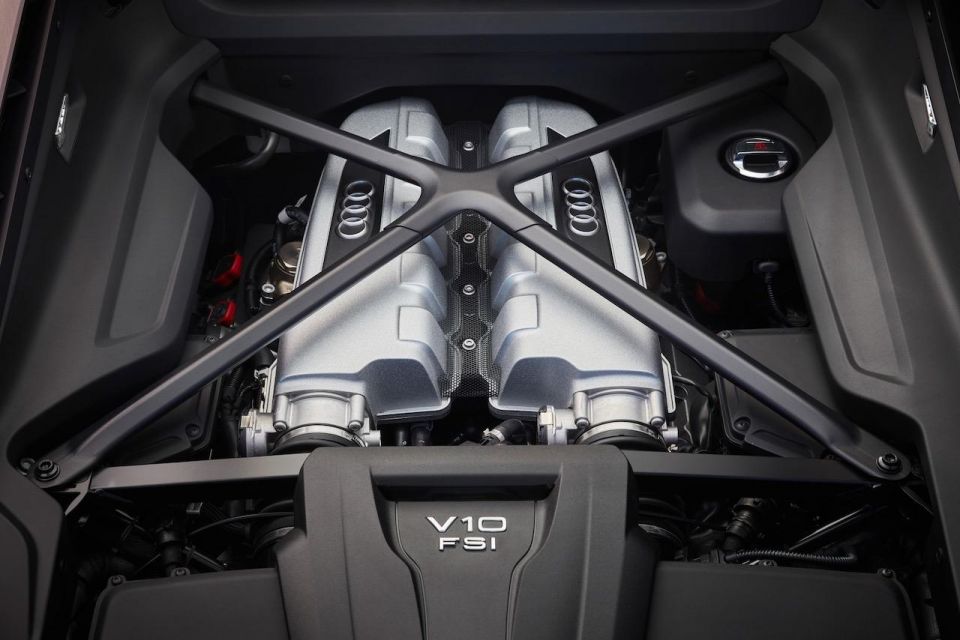
Again, due to the lack all-wheel drive grip off the starting line, the Audi R8 RWD needs 3.7 seconds (3.8 secs for the Spyder) to go from 0-100km/h. Top speed is the same 330km/h.
The car’s’s Lamborghini Huracan LP580-2 sister car with the same engine develops more power and can go from zero to 100km/h in 3.4 seconds thanks to less overall weight.
There’s never been a more accessible supercar than an Audi R8. That’s the way it’s been from the moment it first rolled off the production line in 2006, hand built as it is.
Nothing has changed. Fire up the V10, listen to it for a few moments and then boom, enjoy that noise because it may well be the last Audi built with a naturally-aspirated V10.
Get ready for super capacitors and hybrid powertrains in future Audi supercars. But for the moment at least, driving an R8 is still a wonderfully visceral experience, and it doesn’t really matter which one you’re in.
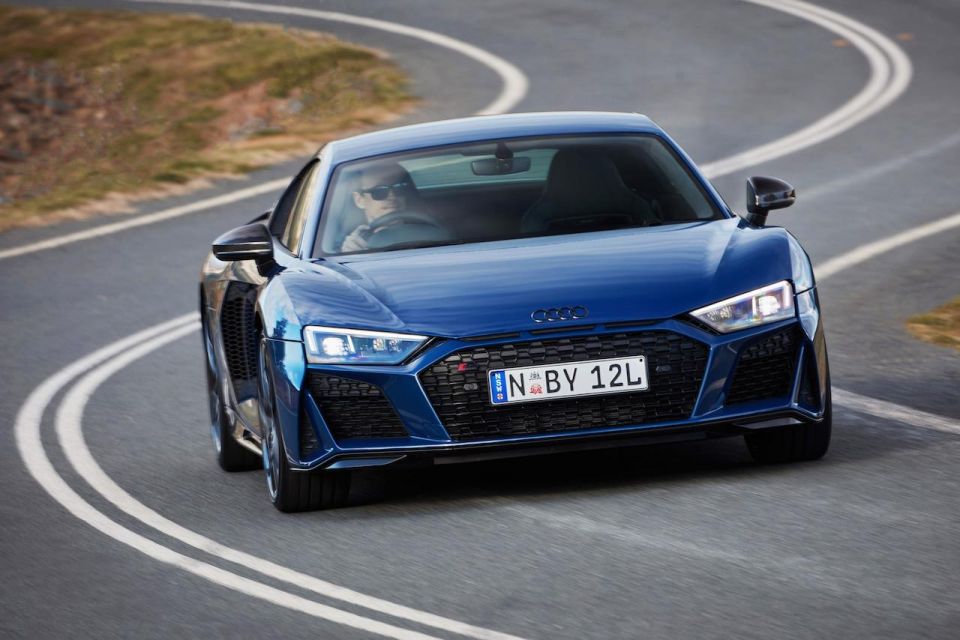
There’s something special about the R8 V10 RWD. It sings the same magnificent noise every time the revs build to an 8000rpm-plus crescendo, and while I know it weighs the same as the Performance it feels somehow lighter, with sharper steering response.
I’m following Luke Youlden (admittedly he’s only in a TT S) but the guy can drive and he’s not hanging about. I can tell he’s enjoying it, but nowhere near as much a me in the R8.
It feels completely settled on these bumpy B-roads, there are no heart-stopping moments even when the pace got furious at times.
The 5.2-litre V10 and seven-speed dual-clutch are perfect sync and the shifts (up or down) make you feel like a hero. I can’t think of a supercar that does this so easily, but at the same time connects with you in a way that doesn’t intimidate.
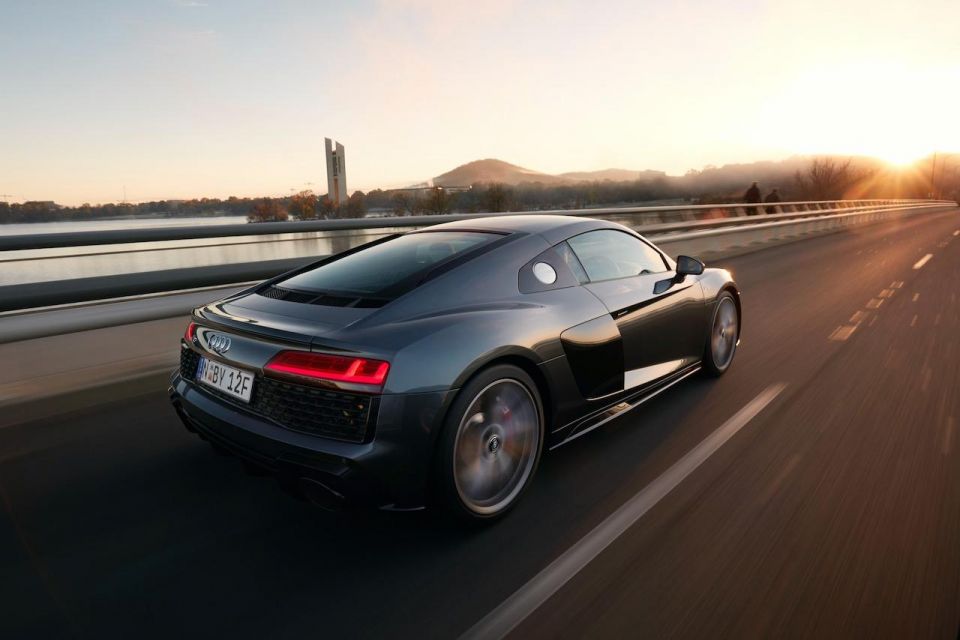
At times I felt I wanted a bit more power, but I’d ask what for. This is perfect without being sketchy. There’s even more fun to be had when you get on lean on the throttle early on exit and you feel the rear end get some slip angle.
That’s more fun than going faster in the quattro, although the sheer pace carried by the latter in some of the more challenging corners is amazing.
The throttle is also wonderfully responsive to the smallest of inputs, and the power delivery is beautifully linear thanks to that V10. You don’t get the kind of immediacy you crave for in a car like this from turbocharging. It’s still just so refreshing.
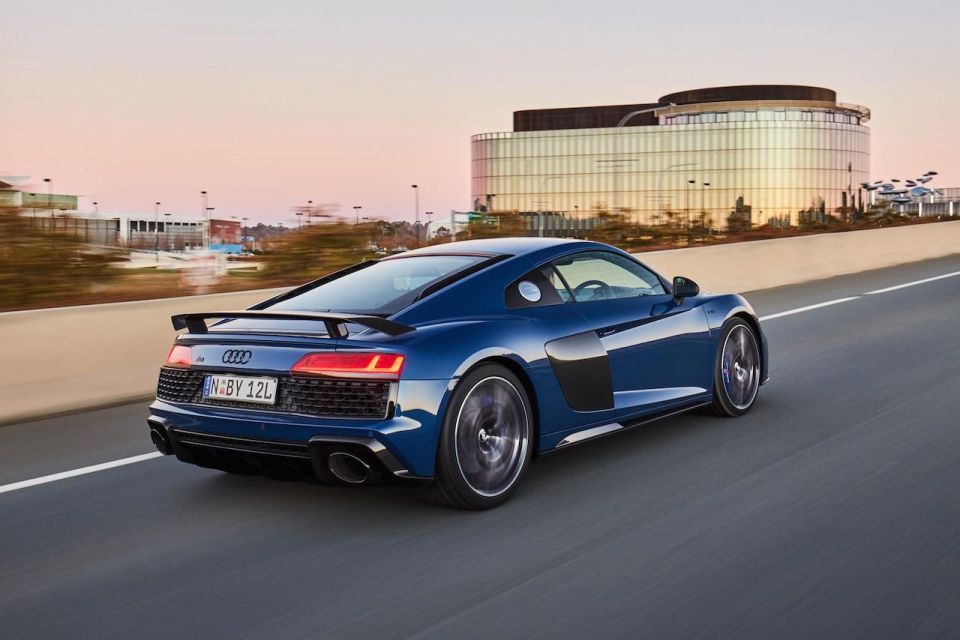
Swapping into the R8 V10 Performance quattro doesn’t feel like much of a change. Sure, there’s 50kW more power and all-wheel drive for extra grip, but I’m not sure it improves the driving experience in the dry.
In the wet, it’s an entirely different thing and Audi’s quattro system is practically bulletproof when it comes to high-speed wet weather traction.
There’s good feedback from the R8’s electromechanical power steering, and it’s nicely weighted for quick changes of direction on the B-roads we were attacking.
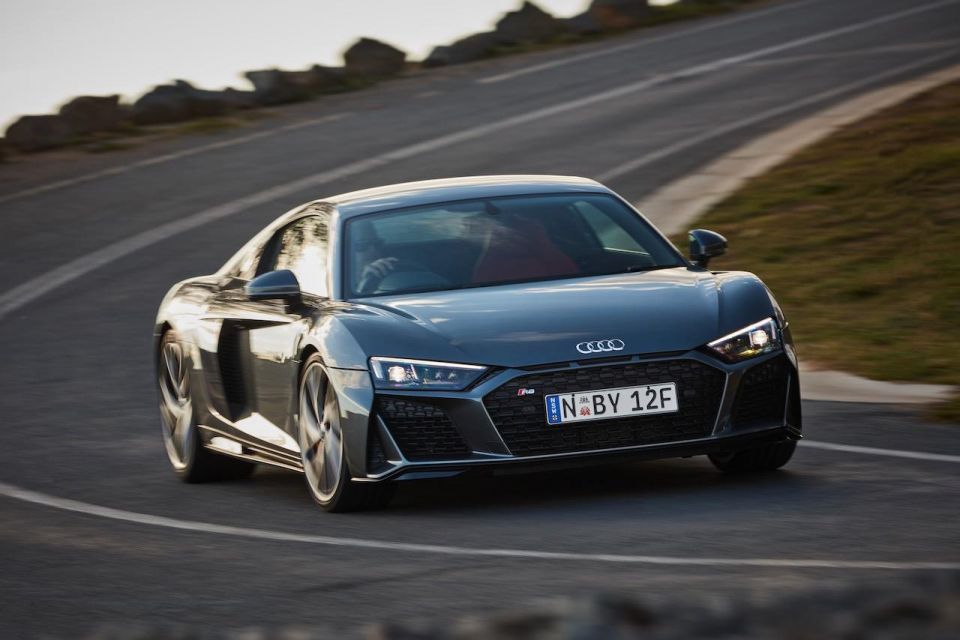
While ride comfort definitely improved in the Performance quattro version with Audi’s magnetic ride as standard, it wasn’t like the passive suspension set-up on the RWD version was anywhere near bone-jarring.
Even if you track your R8 RWD the brakes are likely to manage with enough cool down time between sessions, but there’s no denying the huge stopping power from the carbon ceramic versions on the quattro. They’re most likely overkill for most buyers.
While I like the extra power and grip of the Performance quattro, I’m leaning towards the Audi R8 V10 RWD for its more seat-of-the-pants feeling behind the wheel.
Audi claims 12.0L/100km for the V10 RWD Coupe and 12.2L/100km for the Spyder version on a combined cycle, while the V10 Performance quattro claims 13.4L/100km for the Coupe and Spyder versions.
Unfortunately, our test route was mostly on country B-roads without any regard for fuel consumption. Once we get the R8 through the CarExpert combined test cycle we’ll be able to provide some real-world figures.
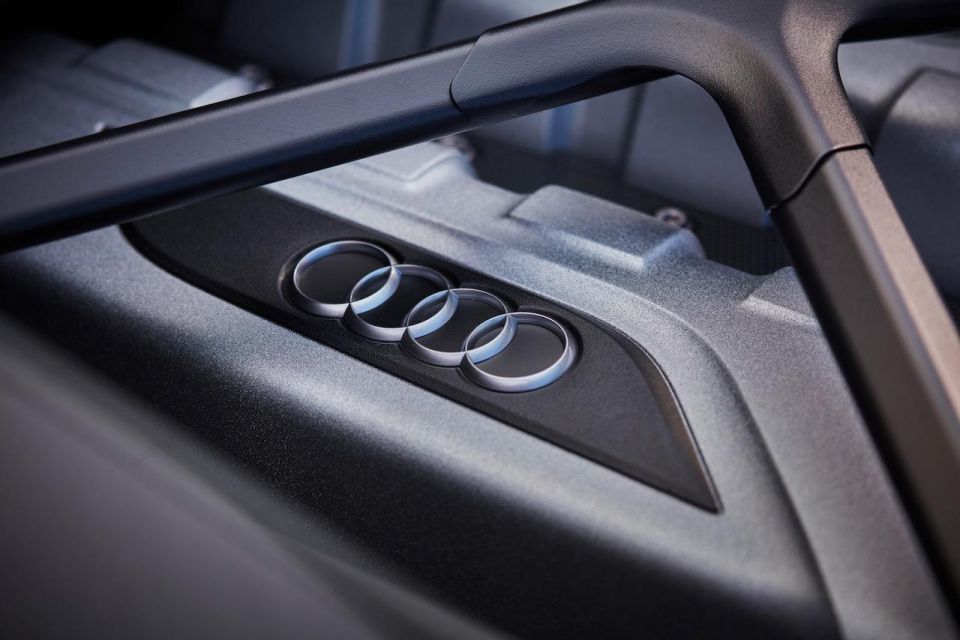
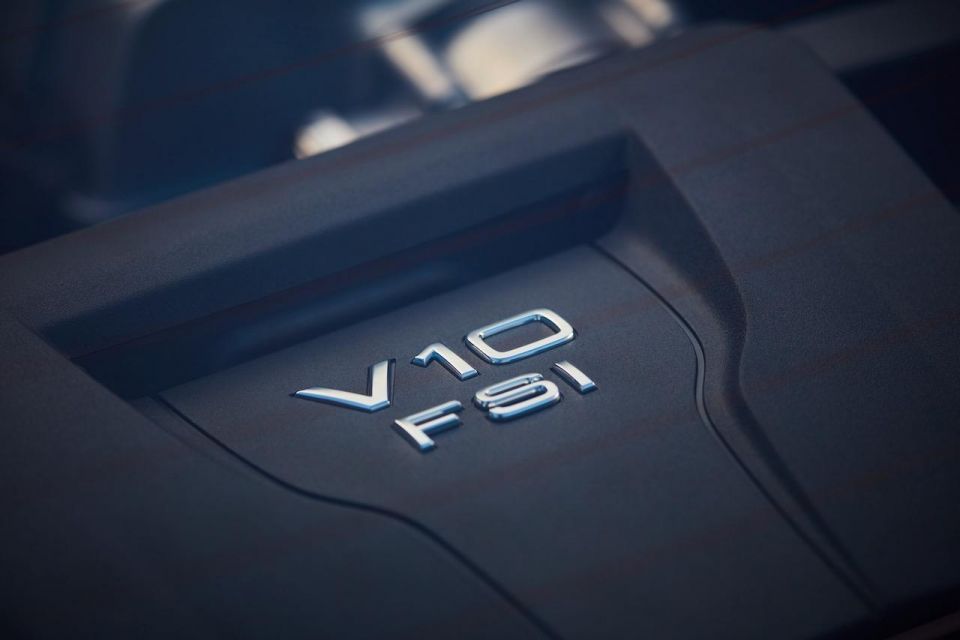


The good news is the R8 is offered with a complimentary three-year Audi service plan package as well as a three-year, unlimited-kilometre warranty.
There are also new vehicle extended warranty plans available to cover your vehicle for up to 48 months with a maximum 160,000km.
Any differences between the new 2020 Audi R8 and its predecessor are largely incremental, and likely not felt by most drivers. That doesn’t mean it’s not one of the world’s great driver’s cars, because it surely is.
While at times I craved the additional power and sure-footedness of the R8 V10 Performance quattro Coupe on a twisty country B-road, emotionally I’m more attached to the visceral pleasures of piloting the RWD.
It just feels more connected to me, and more about the driver than the car.
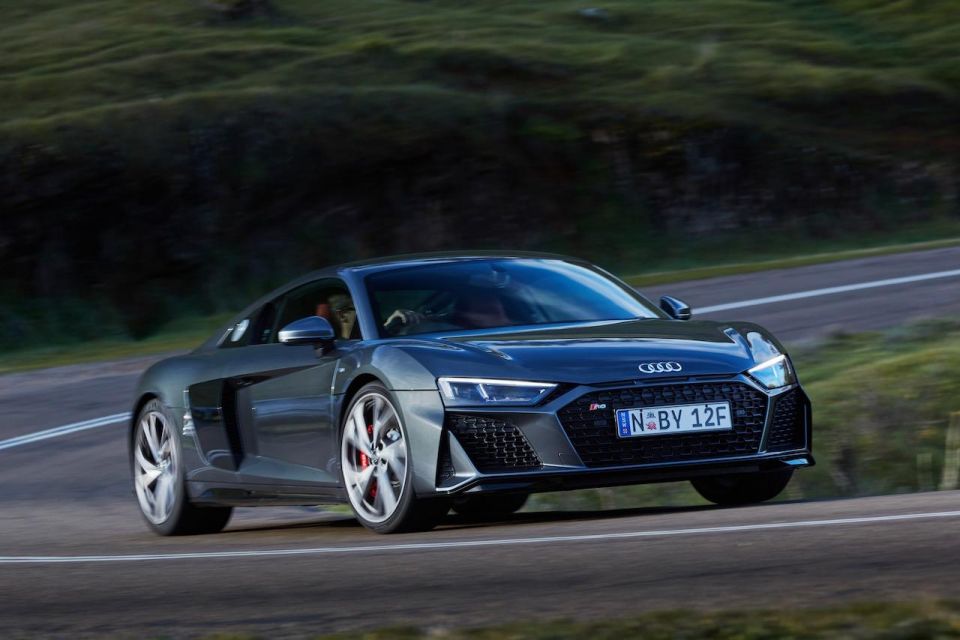
Either way, it’s an epic journey in either version and one that is unique to the R8. For how long, who knows.
I still miss the six-speed manual shift and the shapely profile of the original. Just saying.
Where expert car reviews meet expert car buying – CarExpert gives you trusted advice, personalised service and real savings on your next new car.


Paul Maric
6 Days Ago
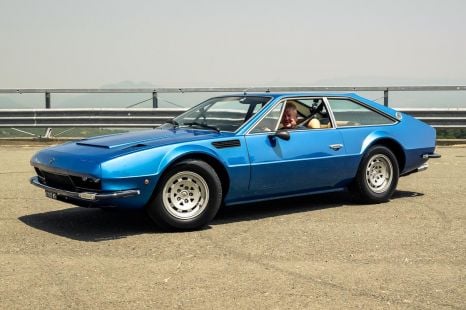

Anthony Crawford
5 Days Ago


Max Davies
4 Days Ago


James Wong
3 Days Ago


James Wong
2 Days Ago


Max Davies
1 Day Ago